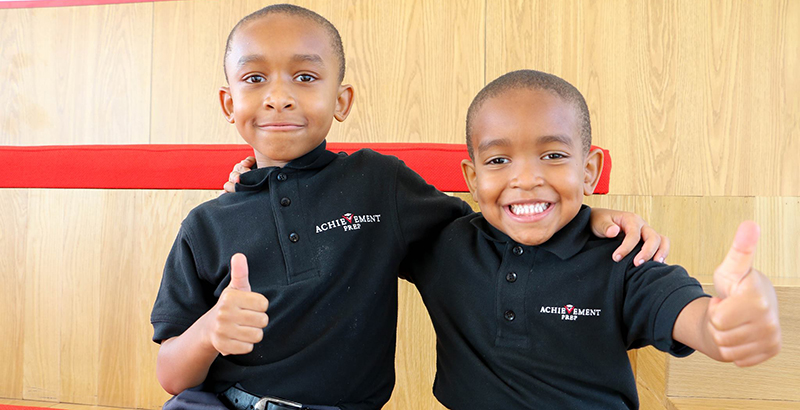Whether Learning is In-Person or Remote, Mental Health of Students Traumatized by COVID Can’t Be Ignored

Schools around the world started classes this year that looked very different in most cases than they did a year ago. Facing many uncertainties, school administrators devised flexible plans with multiple scenarios, including social distancing protocols, guidance on mask wearing, continued reliance on virtual learning, and ways to ensure scholars are getting proper nutrition if the schools are still conducting classes remotely.
Like other schools in the Washington, D.C. area, Achievement Preparatory Academy is following guidance from local health officials and government agencies and conducting its classes 100 percent virtually. We have incorporated lessons learned from the spring semester and are providing a mix of live and pre-recorded instruction as well as computers and school supplies for all scholars and training for families to support them in the virtual learning environment.
But regardless of how or when students return to their classrooms, there’s a troubling new issue we cannot ignore: the mental health of young students traumatized by the ongoing coronavirus pandemic, worldwide protests calling for racial justice, and fear students and their parents may be feeling around high unemployment and an economic crisis that will largely impact poor and underserved communities more than others.
The fact is that nearly everyone’s mental health has been impacted by these events. Even in families where no one contracted COVID-19, there have been countless changes to what “normal life” looked like. Team sports and practices have stopped. Contact with friends has abruptly ended. Entire families have been cooped up at home trying to work and learn in the same space. And vacations, birthday parties, and holiday celebrations have been canceled. For too many families, the pandemic has also meant deep concerns about bills and food insecurity.
All this against the backdrop of constant news stories chronicling the increasing COVID-19 death toll, mounting job losses, and civil unrest stoke grave insecurities in children and their families.
Psychologists and sociologists are advising that teachers are likely to see – both in scholars and themselves – conditions including trauma, post-traumatic stress disorder (PTSD), agoraphobia, hypochondria, and obsessive-compulsive behavior, as well as an increase in incidents of anxiety. Recess won’t be 100 kids running around playing tag on the playground and then coming into the cafeteria to have lunch together, side-by-side. The fact that “back to physical classrooms” won’t be back to what we thought of as “normal,” means that for any school environment, there will be mental stressors on scholars and staff.
Many scholars, parents, and teachers can be expected to feel scared or anxious. They will need to be reassured that those feelings are normal. Since many children, especially young children, may not know how to express their emotions, teachers, parents, and staff need training and coping strategies to ease stress. They will also need those skills for themselves.
“Teachers will usually be the first ones to see changes in behavior since they are on the front line with scholars,” notes Michele Swinson, CEO of AprilMay Company, a pediatric organization serving the mental health needs of children in the Washington, D.C. community and the city’s public and charter schools. “Undoubtedly, teachers will also need social and emotional support, and cannot be the only resource for students.”
Teachers and staff need to be taught to recognize the signs of mental health disturbances, and how and when to get scholars the right support they need. While it is impossible to accurately diagnose a mental health disorder without some one-on-one discussions with the person, there are some behaviors that may signal that someone needs help. These include anger (which can be a sign of depression), lack of regard for things the person used to enjoy, changes in sleep patterns (sleeping much more or much less), engaging in high-risk activities without regard to the person’s own health, and the inability to concentrate.
“A child who is acting out might be doing that based on anxiety or fear. Parents and teachers need to know how to recognize where emotions are coming from so they can help,” Swinson adds.
One essential feature will be trauma-informed classrooms, which give students space to show their emotions without feeling that something is wrong. These classrooms include quiet spaces for scholars who are feeling overwhelmed and teachers who establish clear and predictable schedules that provide a sense of security.
One of the biggest challenges in a post-COVID (or continuing-COVID) school environment that is also affected by racial and economic concerns will be how to socialize in a way that is safe. School is such an enormously important space for children to learn social skills while interacting with others. Losing the experience of a busy lunchroom or groups of kids outside at recess means opportunities to socialize will be limited.
It will be equally important for staff to talk with students, especially younger ones, about why the school culture has changed and ask them for ideas about how to connect and interact while still following new rules. While they may not have a lot of words to describe how they are feeling, kids know what they like and what they don’t like. Inviting them to help with solutions to be “safely social” will get their buy-in, ease some fears and probably result in creative ideas that adults may have overlooked.
Schools will also want to consider using recess time or breaks in online instruction more actively for emotional development. This may include conversations in small groups to talk about how they are feeling, what they are scared about, or one good thing that happened to them that day.
The resources available to help scholars with their mental health will vary greatly depending on the school’s own programs, partners, and local agencies. At Achievement Prep, we are fortunate to have a strong in-house team, as well as a partnership with AprilMay, who has increased the mental health services it is providing not only to our scholars but also to staff and families.
As schools build their new cultures, it is vital that the process remains collaborative. Input from parents, teachers, administrators, and students must be heard and respected. That, in turn, will build consensus, increase acceptance of the new plans, and lessen anxiety around the changes.
There is no doubt that what school looks like now is very different and more challenging than anything we have seen before. But it also gives us a chance to integrate mental health into classrooms as never before. And that could be the start of something great for our children and ourselves.
Steaven R. Hamlin, Jr. is the director of scholar support at Achievement Preparatory Academy, a Washington, DC-based public charter school that serves Ward 8 in Southeast D.C.
Get stories like these delivered straight to your inbox. Sign up for The 74 Newsletter


